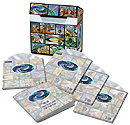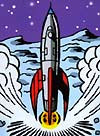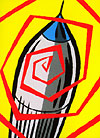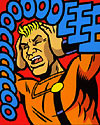|
SUPPORT THIS SITE! PLEASE ORDER JOURNEY INTO SPACE THROUGH
|
JOURNEY INTO SPACE: OPERATION LUNACD Collector's Edition Reviewed by Ceri Laing Writer / Producer: Charles ChiltonStarring: Andrew Faulds, Alfie Bass, Guy Kingsley Poynter, David Williams, David Jacobs“Gentlemen, we’re on the moon…” THE SERIAL
In 1953, following the success of his Western drama for BBC Radio – Riders of the Range - writer/producer (producer as in the old school BBC term of director / producer) Charles Chilton was asked to turn his hand to a similar serial, but in the rapidly growing popular genre of Science Fiction. Journey into Space was what he created and the half-hour episodes ran for eighteen weeks from September 1953 on the BBC Light Programme (the forerunner to BBC Radios 1 and 2). Subtitled A Tale of the Future it charted the exploits of the crew of the rocket ship Luna and man’s first venture into space to visit the moon in the then future of 1965. Luna was manned by Captain Andrew “Jet” Morgan, radio operator Lemuel “Lemmy” Barnet, ship doctor “Doc” Matthews and engineer Stephen “Mitch” Mitchell. The story so far….
Just as time is running out, on the last day of supplies, with barely enough for the trip back to Earth, all power is returned. Outside they find the strange craft which they saw on the “televiewer”. Before leaving for Earth Jet and Mitch decide to go out and take photographs of the object. While doing this Mitch discovers an open door and, once inside, he explains over the radio what he can see. Suddenly he starts talking strangely, as if he’s been taken over, saying that the ship has come from the other side of the universe, and that primitive beings such as Earthmen couldn’t understand how this would be possible and that the secret is time. Mitch comes to his senses and leaves the craft as it starts to move and then fly off. Back at Luna, Jet believes the craft must be able to time travel, which would explain some of the weird occurrences that have befallen them and how it could travel such vast distances. Finally, the crew assemble for take-off and they return to the Earth. They orbit the Moon, allowing man to finally see the satellite’s dark side. While enjoying this spectacle a whole host of craft like the one they saw suddenly appear from one of the craters, heading in their direction. They get into position for the firing of the rocket motors and, just as they fire, the craft surround them and they are catapulted to who knows where… The serial became such a success that a follow-up was commissioned, retaining the names Journey into Space and A Tale of the Future – but subtitled The Red Planet – which was broadcast a year later for twenty weeks, from September 1954. Set in 1971, six years after the first story, this time the crew head for Mars and discover a planned Martian invasion. The following year saw the final story of the 1950s trilogy, subtitled The World in Peril, again running for twenty weeks. It was broadcast from September 1955, and set two years after the second story, in 1973, detailing the crew’s attempts to thwart the Martian invasion. Despite its success, the master tapes for the first Journey into Space serial were wiped following transmission, as was BBC policy at the time. The second and third series were also wiped, but not before the BBC Transcription Service (the division of the BBC that sold their programmes overseas) had made their own copies. In order that they could offer the complete Journey into Space trilogy as a sales package, the BBC Transcription Service decided to re-make the original series in 1958. This was big year for the Transcription Service as re-makes of early episodes of The Goon Show and Hancock’s Half Hour, amongst others, were also recorded to enhance their sales catalogue. Their re-make was subtitled Operation Luna (with the original serial having been dubbed Journey to the Moon for internal paperwork, following the commissioning of The Red Planet).
Cast changes were also made for the new version. Throughout all three 1950s serials and the re-make “Jet” Morgan was played by African-born Andrew Faulds. Faulds had also appeared in several episodes of the TV version of Hancock’s Half Hour and Hancock, including the voice of “Mayday” in The Radio Ham. Other enduring roles include playing Phalerus in Jason and the Argonauts, in 1963, and appearances in four Ken Russell movies (The Devils, The Music Lovers, Mahler and Listzomania), as well as Russell’s 1967 Omnibus production of Dante’s Inferno. In later life he became an MP. Guy Kingsley Poynter appeared as the quietly calm American, “Doc”, in all the 1950s serials. For the original serial and The Red Planet ever-loyal, ever-cheery Cockney Lemmy was played by David Kossoff. When Kossoff decided not to play the part anymore he recommended Alfie Bass, who was rapidly becoming known from parts in The Lavender Hill Mob and in ITV’s The Adventures of Robin Hood, believing him to be perfect for the role. Bass joined the cast for The World in Peril and carried on with the part for Operation Luna. Several actors played the abrasive Australian, Mitch. For half of the original serial the part was taken by Bruce Beeby. When he had to leave Don Sharp took over. Beeby returned as Mitch for The Red Planet as did Sharp for The World in Peril. For the re-make the role was taken by a new actor, David Williams. The other stalwart of the series is David Jacobs (best known as the presenter of the original Juke Box Jury and as a disc jockey who is still enjoying tenure on BBC Radio 2). Jacobs is an actor of enormous vocal talent, playing numerous bit-characters throughout the three serials and the re-make. He was so well liked among the team that Chilton built-up one of characters in The Red Planet, Frank Rogers, who would become a series regular reappearing in The World in Peril. Jacobs was also the main announcer for the series, interchanging these duties with Guy Kingsley Poynter on the occasional times when he was unable to attend recordings. One other actor who also needs a mention is Deryck Guyler, famous at the time for appearances in ITMA, but more familiar to later generations through his roles in as the caretaker in Please Sir! and as PC “Corky” Turnball in Sykes. He appeared in the Journey to the Moon and reprised the part in the re-make. I won’t mention who that character is in case you haven’t heard the serial, as it’s a pivotal one for the story beyond what I’ve summarised above.
In 1979, two decades after the three serials and the re-make, Chilton was asked to write a follow-up play to find out what happened to Jet and his three crewmen. The new ninety-minute play, entitled The Return from Mars, featured new actors. It was entertaining, but failed to capture the magic of the original serials. The story was also supposed to tie-up with the finale of The World in Peril, but the events differ drastically, as Chilton had forgotten how it ended! In 1984 Chilton was asked to create a new serial in the style of the original series. The six half hour episodes, entitled Space Force, featured four main characters which are identical to the four from Journey into Space in all but name, and slight revisions for the 1980s. The story also re-utilises themes and ideas from the original first serial as well. A six-part follow-up a year later did the same, but took The Red Planet as its inspiration. On the whole the two serials were better than the ninety-minute play, but don’t come anywhere near the quality of the three original serials, basically because the original serials were of their time.
“…I better explain to our listeners that the delay in reply between the Moon and the Earth is due to the Moon’s distance from us – the time taken for radio waves to travel that distance…” THE DISCS Since the master tapes for the original three stories were known to have been wiped, the only copies that could have survived were the recordings made by the Transcription Service, but these too had long been thought to be lost. No copies were known to exist, until 1986, when BBC recording engineer Ted Kendall found a mis-filed pile of 16-inch coarse groove transcription discs which amazingly contained all three serials. After a painstaking transfer to tape, and some rudimentary clean-up the three serials were broadcast for the first in over 30 years, on BBC Radio 2 during 1989. Further information on the find and restoration process can be found here. The serials were then released on cassette tape in 1989, 1991 and 1994 respectively. In 1996 further digital restoration was undertaken, and all three serials were again released on cassette, in three individual box sets, and as one complete box set. These were re-issued in 1998.
When The Red Planet and The World in Peril were released their episodes were edited together to form compilation versions. These were essentially intact, beyond the loss of titles, recaps and the odd music cue or sound effect. When all three serials were re-released in the late 1990s all three were compilations, but intact beyond that, so that the material lost from various edits of Operation Luna were now present. But, of course the cliff-hangers were missing, which are an essential aspect of how the series, and one of is joys. Recently BBC Audiobooks has wisely adopted a policy of releasing Collector’s Edition CD box sets containing material in unedited format, wherever possible. The episodes in this new release are presented intact - what material there is on the transcription discs is all here. As with the previous releases, Ted Kendall has performed the restoration (as he does for the other Collector’s Edition CD box sets of 1950s comedy shows). You wouldn’t want anyone else involved, because of his history with the recordings. You won’t be disappointed - the episodes have never sounded so clean. There’s no trace of hiss or crackle from the battered transcription discs, or other sound faults inherited from the original master tapes, such as print-through. Overall the restoration is a distinct improvement on the late 90s releases. The restoration process for those removed the sound imperfections and improved the clarity, but it made the overall sound very “hard” and lacking the warmth and roundedness of the original recordings. This new release goes a long way to matching the fidelity of how they sounded on the original 1989 release, without all the imperfections. Sound restoration has come on a long way…
The episodes themselves are presented over seven discs – two episodes each disc, with the thirteenth episode and the extras on the last disc. The box set also comes with an extremely detailed booklet, written by Andrew Pixley, which covers the development of the original serial and the re-make, as well as cast lists and broadcast information for both, summaries of the four opening episodes and the material from episodes twelve and thirteen of Journey to the Moon, which wasn’t included in Operation Luna. The booklet also features some contemporary Radio Times clippings, as well as a small article that accompanied the 1989 broadcast. The only thing missing are examples of the novelisation covers, which were included in the late 1990s releases. But they’re hardly missed – as I say it’s extremely detailed; only limited by the space given to the text in the booklet. Andrew Pixley knows so much about the series he should be allowed to write a definitive book – any publishers out there reading this PLEASE - give him a contract! “…the colour contrast between the Earth and Moon is amazing! The Earth’s a beautiful planet, beautiful…” SUMMARY This is a stunning package, and the start of a fantastic set of box sets for the series. Full credit goes to Ted Kendall and Andrew Pixley, as well as the team at BBC Audiobooks. From the restoration of the episodes, finally available complete and unedited for the first time, to the extras, and to the detailed information in the booklet, this is a fundamental improvement on the previous releases.
If you’ve heard the serial before and you liked it you will probably want to purchase the box set anyway, but if haven’t heard it before, why would you want to buy it? What’s so great about it? Surely it’s only some hokey piece of 1950s Sci-Fi? Well, it is, but it’s also much than that. For a start, it’s purely British through and through, and is littered with 1950s cultural references and colloquialisms – cf. Hancock’s Half Hour and The Goon Show – which all adds to the overall charm of the series, and gets you involved with the characters and what happens to them. All the actors are embedded deeply with their roles (apart from the possible exception of Williams who was new to his part). It’s also well-written, encompassing broad drama to small moments of emotion expressed by the characters, coupled with unfolding events and cliff-hangers that keep you addicted.
If you like radio, you’ll love this. If you like science fiction, you’ll love this. This serial will delight and entertain you in equal measure. I can’t recommend it highly enough…. The best, however, is yet to come. The Red Planet, which is widely regarded as the finest of the three serials (and is my personal favourite), will be released next. This superb release of Operation Luna has more than built up my anticipation for the next box set. I wait with baited breath for what Ted Kendall and Andrew Pixley will produce… The Red Planet takes place six years after the adventures of the Luna, in 1971. Jet Morgan and his crew blast-off again, this time from a purpose-built base on the Moon, and in a new ship – the Discovery. The Discovery heads a great space fleet of manned rocket ships on the next part of Man’s exploration of the Solar System. Their eighteen-month mission is to set down on Mars and explore its surface, “…but that’s another story…”
JOURNEY INTO SPACE: THE RED PLANET - REVIEW
With thanks to Andrew Pixley. |


 Journey into Space
was a hugely popular drama series on BBC Radio during the 1950s, and had
the honour of being the last radio series to achieve higher ratings than
that that of TV. Listeners tuned each week to be thrilled by the
adventures and wait with baited breath for the resolution of the previous
episode’s cliff-hanger.
Journey into Space
was a hugely popular drama series on BBC Radio during the 1950s, and had
the honour of being the last radio series to achieve higher ratings than
that that of TV. Listeners tuned each week to be thrilled by the
adventures and wait with baited breath for the resolution of the previous
episode’s cliff-hanger. After problems before launch, the crew
finally blast-off in experimental rocket ship Luna, designed and built by
Mitch. During their journey and stay on the Moon’s surface they experience
a series of strange and uncanny events. Odd sounds are heard
(predominantly heard by Lemmy and dubbed “music” by him), Jet disappears
only to reappear a few hours later after re-living a confused event from
his childhood, peculiar things are seen – structures built on the surface
Moon. Then, most explicably, just as they are about to take-off for their
return to Earth, all power leaves the ship and they are left stranded,
with a tiny amount of their meagre rations, and a slowly dwindling oxygen
supply. During this loss of power their “televiewer” momentarily starts
into life and a doughnut-shaped craft is seen hovering in front of Luna,
and knocking sounds are heard all around the outside of the hull.
After problems before launch, the crew
finally blast-off in experimental rocket ship Luna, designed and built by
Mitch. During their journey and stay on the Moon’s surface they experience
a series of strange and uncanny events. Odd sounds are heard
(predominantly heard by Lemmy and dubbed “music” by him), Jet disappears
only to reappear a few hours later after re-living a confused event from
his childhood, peculiar things are seen – structures built on the surface
Moon. Then, most explicably, just as they are about to take-off for their
return to Earth, all power leaves the ship and they are left stranded,
with a tiny amount of their meagre rations, and a slowly dwindling oxygen
supply. During this loss of power their “televiewer” momentarily starts
into life and a doughnut-shaped craft is seen hovering in front of Luna,
and knocking sounds are heard all around the outside of the hull.
 The 1958 re-recording gave Chilton a chance
to amend the script of the original serial. Writing week-on-week he (like
Spike Milligan) was best working to deadlines. The initial episodes of
Journey to the Moon had proved unpopular with listeners, whilst
Chilton found his feet with the new genre. During the writing of the
original serial he revised his ideas and decided to abandon several
characters and introduce new ones. The show started to become a success
when Luna finally got off the ground at the start of episode five. By then
the four main characters and the format of the serial had become
established, and the popularity of the programme soared. This template
formed the basis of the two follow-up serials. Chilton jettisoned the
opening four episodes for the re-make, beginning the story with the launch
of Luna. Other material was dropped from episodes twelve and thirteen as
well, meaning the new version lasted thirteen episodes overall. The
revised Transcription Service version was then broadcast in March 1958.
The 1958 re-recording gave Chilton a chance
to amend the script of the original serial. Writing week-on-week he (like
Spike Milligan) was best working to deadlines. The initial episodes of
Journey to the Moon had proved unpopular with listeners, whilst
Chilton found his feet with the new genre. During the writing of the
original serial he revised his ideas and decided to abandon several
characters and introduce new ones. The show started to become a success
when Luna finally got off the ground at the start of episode five. By then
the four main characters and the format of the serial had become
established, and the popularity of the programme soared. This template
formed the basis of the two follow-up serials. Chilton jettisoned the
opening four episodes for the re-make, beginning the story with the launch
of Luna. Other material was dropped from episodes twelve and thirteen as
well, meaning the new version lasted thirteen episodes overall. The
revised Transcription Service version was then broadcast in March 1958. The other thing you cannot escape if you
hear Journey into Space are the sound effects and the music, the
latter of which was written and conducted by Van Phillips. Both are
extremely memorable. The music underpins the acting beautifully, from the
epic to the subtle, as well as creating a “celestial” presence – it’s
neither weak nor overbearing. The sound effects and the music enhance the
series beyond measure and both fit perfectly together within the
soundscape created by Chilton.
The other thing you cannot escape if you
hear Journey into Space are the sound effects and the music, the
latter of which was written and conducted by Van Phillips. Both are
extremely memorable. The music underpins the acting beautifully, from the
epic to the subtle, as well as creating a “celestial” presence – it’s
neither weak nor overbearing. The sound effects and the music enhance the
series beyond measure and both fit perfectly together within the
soundscape created by Chilton. When Operation Luna was broadcast in
1989 it featured lots of minor edits. Different edits were applied to the
initial audiotape release. These cuts were of various things, such as
sections of lines, music cues and sound effects, from throughout the
episodes. The edits to the 1989 broadcast were presumably to fit the
broadcast time slot, but the edits to the audiotape version were seemingly
part of the revisionist attitude of the 1980s, when there was a need felt
to “tighten-up” archive material for a modern audience. In addition to
that, for the cassette release, episode twelve was split in half and the
material added to episodes eleven and thirteen, meaning the serial became
twelve episodes overall. This was done so that there was an even number of
episodes, making it easier for presentation on cassette.
When Operation Luna was broadcast in
1989 it featured lots of minor edits. Different edits were applied to the
initial audiotape release. These cuts were of various things, such as
sections of lines, music cues and sound effects, from throughout the
episodes. The edits to the 1989 broadcast were presumably to fit the
broadcast time slot, but the edits to the audiotape version were seemingly
part of the revisionist attitude of the 1980s, when there was a need felt
to “tighten-up” archive material for a modern audience. In addition to
that, for the cassette release, episode twelve was split in half and the
material added to episodes eleven and thirteen, meaning the serial became
twelve episodes overall. This was done so that there was an even number of
episodes, making it easier for presentation on cassette.  If having the episodes in the best-possible
sound quality wasn’t enough, you get extras as well! Of main interest to
anyone who knows the serials already is the only surviving extract from
Journey to the Moon – a five and half minute piece (not ten minutes,
as is claimed on the back of the box!) This is from the end of the final
episode, and, apart from the differing actors, also features different
music. The clip only exists because it was retained by the BBC Sound
Archives as an example of what the programme was like. It was their policy
at the time to keep extracts of the BBC's output, but not whole
recordings. The clip has also been restored, but the sound is a little dull,
and not as well rounded as the main recordings, but this will be due to
the original quality of the extract. Also included is the documentary
Journey into Space…Again, which was broadcast in 1999 on Radio 4 and
then released in 2000 as a double-tape release with The Return from
Mars. During the half-hour programme Charles Chilton takes you through
the creation and development of the series, as well as audience reaction
to it. The documentary is peppered with clips from the serials, as well as
extracts from a joint discussion / interview with Chilton, Andrew Faulds
and David Jacobs. It’s a fantastic introduction to the series for those
who are new to it, as well as being a mini-celebration for existing fans.
If having the episodes in the best-possible
sound quality wasn’t enough, you get extras as well! Of main interest to
anyone who knows the serials already is the only surviving extract from
Journey to the Moon – a five and half minute piece (not ten minutes,
as is claimed on the back of the box!) This is from the end of the final
episode, and, apart from the differing actors, also features different
music. The clip only exists because it was retained by the BBC Sound
Archives as an example of what the programme was like. It was their policy
at the time to keep extracts of the BBC's output, but not whole
recordings. The clip has also been restored, but the sound is a little dull,
and not as well rounded as the main recordings, but this will be due to
the original quality of the extract. Also included is the documentary
Journey into Space…Again, which was broadcast in 1999 on Radio 4 and
then released in 2000 as a double-tape release with The Return from
Mars. During the half-hour programme Charles Chilton takes you through
the creation and development of the series, as well as audience reaction
to it. The documentary is peppered with clips from the serials, as well as
extracts from a joint discussion / interview with Chilton, Andrew Faulds
and David Jacobs. It’s a fantastic introduction to the series for those
who are new to it, as well as being a mini-celebration for existing fans. The only fault I have with the box set is
the packaging. The cardboard box design and slipcases for the CDs used in
the Collector’s Edition CD box set releases from BBC Audiobooks has been
rightly criticised before – it doesn’t afford much protection, which is
something of great importance in anything you buy, but especially so when
the RRPs of the box sets are so high (for example Journey into Space:
Operation Luna retails for £60.00, and other box sets have
higher RRPs – the following two serials, at twenty episodes apiece, will
presumably have a higher RRP). However, this issue aside the packaging is
a dramatic improvement in design over the previous box sets. BBC
Audiobooks has taken the trouble to commission superb all-colour Dan Dare-style
illustrations of key scenes from the serial in a 1950s comic strip style
which adorn the box. Whilst the design of the four crew members aren’t
exactly how I’ve always imagined them – they’re all far too muscular and
square jawed – it’s extremely eye catching, and will sit well on shop
shelves encouraging a lot of new purchases. BBC Audiobooks is rightly
proud of the illustrations, as a poster of them all is included in the
set. (Some of the frames are dotted around this review). A lot of care and attention has gone into the overall design. In fact
a lot care and attention has gone into all aspects of the box set.
The only fault I have with the box set is
the packaging. The cardboard box design and slipcases for the CDs used in
the Collector’s Edition CD box set releases from BBC Audiobooks has been
rightly criticised before – it doesn’t afford much protection, which is
something of great importance in anything you buy, but especially so when
the RRPs of the box sets are so high (for example Journey into Space:
Operation Luna retails for £60.00, and other box sets have
higher RRPs – the following two serials, at twenty episodes apiece, will
presumably have a higher RRP). However, this issue aside the packaging is
a dramatic improvement in design over the previous box sets. BBC
Audiobooks has taken the trouble to commission superb all-colour Dan Dare-style
illustrations of key scenes from the serial in a 1950s comic strip style
which adorn the box. Whilst the design of the four crew members aren’t
exactly how I’ve always imagined them – they’re all far too muscular and
square jawed – it’s extremely eye catching, and will sit well on shop
shelves encouraging a lot of new purchases. BBC Audiobooks is rightly
proud of the illustrations, as a poster of them all is included in the
set. (Some of the frames are dotted around this review). A lot of care and attention has gone into the overall design. In fact
a lot care and attention has gone into all aspects of the box set. The long running
time of the serials allowed the story to develop at a natural pace, and
gave Chilton more room to expand the world of Journey into Space
and its characters – to give them more definition and substance. It also
gave him a chance to explore socio-cultural concerns that he felt strongly
about, such as the destruction of the environment and the more aggressive
aspects of man’s character, both of which run through all his work, as
well as a look at the impact and influence of television on the mass
public in the later serials. He deals with these issues in an intelligent,
telling way and they are as relevant now as they were in the 1950s. It’s
these aspects of the story-telling which carry the series beyond just
standard Boy’s Own Adventure yarns. Operation Luna’s story
unravels far beyond what I’ve summarised above...
The long running
time of the serials allowed the story to develop at a natural pace, and
gave Chilton more room to expand the world of Journey into Space
and its characters – to give them more definition and substance. It also
gave him a chance to explore socio-cultural concerns that he felt strongly
about, such as the destruction of the environment and the more aggressive
aspects of man’s character, both of which run through all his work, as
well as a look at the impact and influence of television on the mass
public in the later serials. He deals with these issues in an intelligent,
telling way and they are as relevant now as they were in the 1950s. It’s
these aspects of the story-telling which carry the series beyond just
standard Boy’s Own Adventure yarns. Operation Luna’s story
unravels far beyond what I’ve summarised above...